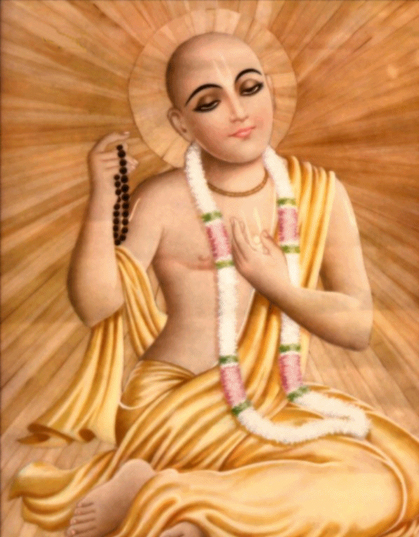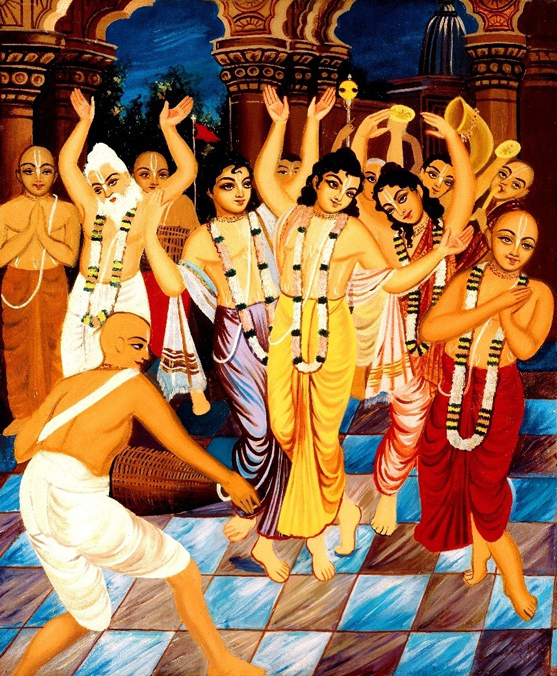Yuga-dharma – Religion in the four Ages
Yuga means age and dharma means religion, religious duties, divine law. For each of the four ages – satya-, treta-, dvāpara- and kali-yuga – there is a particular dharma for spiritual progress, bliss and liberation, because people possess different qualities of strength, life span, inclination etc. due to the influence of sattva, rajas and tamas in each of these ages and the conditions of life are different.
In the Satya-yuga, the life span of human beings on earth is up to 100,000 years. Pure, wholesome food is abundant in the form of fruits, vegetables, etc., and does not need to be cultivated. People are mainly engaged in meditation on Śrī Viṣṇu, the Supreme Lord as the Supersoul in the heart, and thus attain liberation.
In the Treta-yuga, dharma consists of the performance of opulent sacrifices, which certainly no one can perform today because of the lack of means and the absence of qualified priests who can recite the necessary mantras. The life span of human beings is generally 10,000 years.
In the Dvāpara-yuga, where the life span of humans is still up to 1000 years, the Supreme Lord is worshipped by offering service to His mūrtis (transcendental image figures of the Supreme Lord) through offerings and prayers in large temples. Such worship is still practised in many temples today, but not to the same extent as in the dvāpara-yuga. Temples today are smaller and less numerous; indeed, in many countries of the world there are no Vedic temples at all, and people, because of their ignorance and immersion in material existence, are not interested in worshipping the Personality of Godhead in temples, if they are interested in God at all.
“I offer my respectful obeisances to the Supreme Personality, expanded as Vasudeva, Sankarsana, Pradyumna and Aniruddha.”
By this mantra people worship Sri Krishna in the Dvapara-yuga, it is said in the Caitanya-Caritāmṛta, Madhya-līla, Ch. 20.
 To liberate the fallen, conditioned souls in the Kali-yuga from the mire of ignorance and to enable them to attain love for God and thus liberation through a simple process that can be performed by anyone anywhere in the world, the Lord appeared about 500 years ago in Navadvip, Bengal with a golden radiance as Śrī Kṛṣṇa Caitanya, Gauranga, Gaura Hari, the Golden Avatāra and taught the saṅkīrtana-yajña. Saṅkīrtana means praising together, singing congregationally the glories of the Personality of Godhead and chanting His holy names. Yajña means sacrificial process.
To liberate the fallen, conditioned souls in the Kali-yuga from the mire of ignorance and to enable them to attain love for God and thus liberation through a simple process that can be performed by anyone anywhere in the world, the Lord appeared about 500 years ago in Navadvip, Bengal with a golden radiance as Śrī Kṛṣṇa Caitanya, Gauranga, Gaura Hari, the Golden Avatāra and taught the saṅkīrtana-yajña. Saṅkīrtana means praising together, singing congregationally the glories of the Personality of Godhead and chanting His holy names. Yajña means sacrificial process.
All the Avatāras, incarnations of the Supreme Lord, are described in the revealed Vedic scriptures. The Avatāras who appear in the four Yugas to teach the respective Yuga-dharma are called Yuga-Avatāras.
The appearance of the Golden Avatara is predicted in the Mahābhārata, the Śrīmad Bhāgavatam and other scriptures. The Bhāgavatam states:
“In the age, intelligent people perform saṅkīrtana to worship that incarnation of God who constantly chants the names of Kṛṣṇa. Although His complexion is not blackish, He is Kṛṣṇa Himself. He is accompanied by His associates, servants, weapons and intimate companions.”— Śrīmad-Bhāgavatam 11.5.32
 Śrī Caitanya Mahāprabhu appeared with four principal associates, all of whom are expansions of the Supreme Lord: Śrī Nityananda Prabhu, Advaita Acarya, Śrī Gadadhara and Śrīvas Thakur. Together with them and many other eternally liberated souls from the spiritual world, he established Hari-kīrtana, the Yuga-dharma for this age and founded the Saṅkīrtana movement, the movement of worshipping the Supreme Lord by chanting the Holy Names of God together.
Śrī Caitanya Mahāprabhu appeared with four principal associates, all of whom are expansions of the Supreme Lord: Śrī Nityananda Prabhu, Advaita Acarya, Śrī Gadadhara and Śrīvas Thakur. Together with them and many other eternally liberated souls from the spiritual world, he established Hari-kīrtana, the Yuga-dharma for this age and founded the Saṅkīrtana movement, the movement of worshipping the Supreme Lord by chanting the Holy Names of God together.
hare kṛṣṇa hare kṛṣṇa kṛṣṇa kṛṣṇa hare hare | hare rāma hare rāma rāma rāma hare hare – This is the mahā-mantra, the great hymn of liberation, the most important, most powerful and best of all mantras. By purely chanting and speaking this transcendental sound vibration, one can attain all perfection and enter the eternal kingdom of God, if one does not commit any offence against the Holy Name.1 And one can also immediately experience spiritual bliss. That is the way in this age, the means to connect with the Supreme Lord.
There are other Holy Names of God like Hari, Govinda, Gopala, Gopinatha, Vāsudeva, Narayana, Nityānanda, Gauranga etc. They are all transcendental, purify the consciousness and grant the highest happiness if chanted or spoken again and again in the proper attitude of mind without offence.
The transcendental pastimes of Śrī Caitanya and His companions and the teachings of Śrī Caitanya have come down to us in various scriptures. The most important of these are Caitanya Caritāmṛta and Caitanya Bhāgavata.
In the Bhagavat-Purāṇa, Śukadeva Gosvami says in conversation with Mahārāja Pariksit:
“My dear king, the kali-yuga is full of faults, but it does have one advantage: simply by practising kṛṣṇa-kīrtana one can be freed from the bonds of matter and be promoted to the transcendental kingdom.”— Śrīmad-Bhāgavatam 12.3.51
Im Bṛhan-Naradiya-Purāṇa heißt es:
harer nāma harer nāma harer nāmaiva kevalam
kalau nāsty eva nāsty eva nāsty eva gatir anyathā
“In the Kali-yuga, there is no other means for spiritual progress and liberation than chanting the Holy Names of Hari (Kṛṣṇa – harer nāma).”2
In the Caitanya-Caritāmṛta, Adi-Lila 17.22-23, Śrī Caitanya Mahāprabhu, the Supreme Lord, says:
“In this age of Kali, the holy name of the Lord, the Hare Krishna Maha-mantra, is the incarnation of Kṛṣṇa. Simply by chanting the holy name, one connects directly with the Lord. Anyone who does this is certainly liberated.”
“In this verse, the word eva (“certainly”) is repeated three times for affirmation, and harer nama (the holy name of the Lord) is also repeated three times for ordinary people to understand.”
Footnotes
1 There are 10 offences that should be avoided at all costs when chanting the Holy Names, the Maha Mantra. They are discussed in detail in the book Harinama Cintamani by Srila Bhaktivinoda Thakur.
2 In the Caitanya-Bhāgavata there is a chapter describing the first great Saṅkīrtan of Śrī Caitanya and his companions, in which an entire city of hundreds of thousands of people participated. This Līla (transcendental performance) is but a drop from the nectar ocean of the Lord's eternal pastimes.
